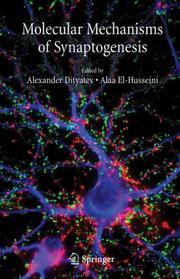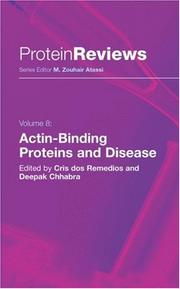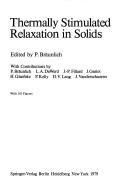| Listing 1 - 10 of 12 | << page >> |
Sort by
|
Multi
ISBN: 9780128097014 0128097019 0128094702 9780128094709 Year: 2018 Publisher: London San Diego, CA Academic Press
Abstract | Keywords | Export | Availability | Bookmark
 Loading...
Loading...Choose an application
- Reference Manager
- EndNote
- RefWorks (Direct export to RefWorks)
Dyneins: Structure, Biology and Disease, Second Edition, offers a broad view of dyneins mechanics, dysfunction, and disease, providing an overview of dyneins from structure and function, to dysfunction and disease. Since the first edition, enormous strides have been taken in understanding dynein structure, its organization in the axoneme, single molecule motor mechanics, and the consequences of defects for human biology, disease, and development. To account for these enormous strides, the second edition is extensively revised. Additionally, the coverage has expanded from 24 to 42 chapters, and is now housed in two volumes. Much of the expanded coverage occurs in Volume 2 which focuses on dynein dysfunction and disease, such as the role of dynein and cancer. Volume 1 covers the history and evolution of dyneins, dyneins in ciliary biology, and cytoplasmic dynein biology, while Volume 2 covers the structure and mechanics of dynein motors and dynein dysfunction and disease. Presents a broad-based and up-to date view of dynein mechanics, dysfunction, and diseaseContains approaches from genetics, molecular biology, biochemistry, and biophysics discussedProvides companion website with movies of dynamic cell behaviorIncludes extensive chapters written by leading, global experts.
Book
ISBN: 0128097027 0128094710 9780128097021 9780128094716 Year: 2018 Publisher: London, United Kingdom
Abstract | Keywords | Export | Availability | Bookmark
 Loading...
Loading...Choose an application
- Reference Manager
- EndNote
- RefWorks (Direct export to RefWorks)
Cytoskeletal proteins. --- Dynein. --- Adenosine triphosphatase --- Microtubules --- Structural proteins --- Proteins
Book
Abstract | Keywords | Export | Availability | Bookmark
 Loading...
Loading...Choose an application
- Reference Manager
- EndNote
- RefWorks (Direct export to RefWorks)
This eBook is a collection of articles from a Frontiers Research Topic. Frontiers Research Topics are very popular trademarks of the Frontiers Journals Series: they are collections of at least ten articles, all centered on a particular subject. With their unique mix of varied contributions from Original Research to Review Articles, Frontiers Research Topics unify the most influential researchers, the latest key findings and historical advances in a hot research area! Find out more on how to host your own Frontiers Research Topic or contribute to one as an author by contacting the Frontiers Editorial Office: frontiersin.org/about/contact
myofilament proteins --- cytoskeletal proteins --- nucleoskeletal proteins --- mutations --- myocyte signaling --- gene expression
Book
ISBN: 0128170697 0128170689 9780128170694 9780128170687 Year: 2019 Publisher: London, United Kingdom
Abstract | Keywords | Export | Availability | Bookmark
 Loading...
Loading...Choose an application
- Reference Manager
- EndNote
- RefWorks (Direct export to RefWorks)
There are 28 different collagens, with 46 unique chains, which allows for a collagen for each time and place. Some collagens are specialized for basement membrane, whereas others are the central structural component of the interstitial matrix. There are eight collagens among the 20 most abundant proteins in the body, which makes these molecules essential building blocks of tissues. In addition, lessons learned from monogenomic mutations in these proteins result in grave pathologies, exemplifying their importance in development. These molecules, and their post-translationally modified products serve as biomarkers of diseases in a range of pathologies associated with the extracellular matrix. Biochemistry of Collagens, Laminins, and Elastin: Structure, Function, and Biomarkers, Second Edition provides researchers and students current data on key structural proteins (collagens, laminins, and elastin), reviews on how these molecules affect pathologies, and information on how selected modifications of proteins can result in altered signaling properties of the original extracellular matrix component. Further, it discusses the novel concept that an increasing number of components of the extracellular matrix harbor cryptic signaling functions that may be viewed as endocrine function, and it highlights how this knowledge can be exploited to modulate fibrotic disease.--
Cytoskeletal proteins --- Purification --- Collagen. --- Cytoskeletal Proteins. --- Avicon --- Avitene --- Collagen Felt --- Collagen Fleece --- Collagenfleece --- Collastat --- Dermodress --- Microfibril Collagen Hemostat --- Pangen --- Zyderm --- alpha-Collagen --- Collagen Hemostat, Microfibril --- alpha Collagen --- Connective Tissue --- Proteins, Cytoskeletal --- Cytoskeleton --- Collogen --- Extracellular matrix proteins --- Connective tissues --- Structural proteins --- Proteins

ISBN: 1280716282 9786610716289 038732562X 0387325603 Year: 2006 Publisher: New York, NY : Springer,
Abstract | Keywords | Export | Availability | Bookmark
 Loading...
Loading...Choose an application
- Reference Manager
- EndNote
- RefWorks (Direct export to RefWorks)
Molecular Mechanisms of Synaptogenesis is a compilation of recent exciting findings that summarizes the ever-expanding knowledge of how neuronal contacts develop in the normal brain and how their functions are affected in mental disorders. In the last decade, advances in molecular and cellular biology, combined with the development of sophisticated fluorescence microscopy tools to visualize synapses in live neurons, have revealed many intriguing and unexpected findings regarding the dynamics of synapse formation. Studies by a number of researchers have identified several critical protein components of synapses and shown the time course of their arrival at the synapse. Several molecules serve to hold the synaptic contacts between nerve cells and regulate their function. Imbalance in synaptic contact formation and function has been linked to psychiatric disorders such as schizophrenia, autism and mental retardation. The recent advances in basic research, summarized in Molecular Mechanisms of Synaptogenesis, may lay the necessary scientific groundwork to develop treatments targeting synaptogenesis, allowing us to improve the lives of people affected by brain disorders. This book will be an invaluable resource for neurobiologists taking their first steps in the expanding and exciting field of synaptogenesis.
Neural transmission. --- Synapses. --- Neurotransmitters. --- Cytoskeletal proteins. --- Presynaptic receptors. --- Neurotransmitter receptors --- Structural proteins --- Proteins --- Chemical nerve transmitters --- Nerve transmitter substances --- Neural transmitters --- Neurohumors --- Neuroregulators --- Synaptic transmitters --- Transmitters, Chemical nerve --- Transmitters, Synaptic --- Neurochemistry --- Neural transmission --- Nerve endings --- Nerves --- Neural circuitry --- Synaptosomes --- Nerve transmission --- Nervous transmission --- Neurotransmission --- Synaptic transmission --- Transmission of nerve impulses --- Neurophysiology --- Neurotransmitters --- Neurosciences. --- Neural sciences --- Neurological sciences --- Neuroscience --- Medical sciences --- Nervous system

ISBN: 1281216933 9786611216931 0387717498 0387717471 1441924531 Year: 2008 Volume: v. 8 Publisher: New York : Springer,
Abstract | Keywords | Export | Availability | Bookmark
 Loading...
Loading...Choose an application
- Reference Manager
- EndNote
- RefWorks (Direct export to RefWorks)
This volume, written by experts in the field, is the first to deal with the relationship between human disease and the actin cytoskeleton. It provides overviews of actin and selected actin-binding proteins, and then focuses on diseases that involve these proteins. Specific chapters deal with actin, cofilin, profilin, gelsolin and thymosin ¾4. Other chapters discuss the roles of multiple actin-binding proteins in cancer and metastasis, leukocyte disorders, and heart failure, and there is a chapter that describes how intracellular pathogens use the host actin cytoskeleton. This seminal volume is intended for researchers, clinicians, physicians, and graduate students in the fields of biochemistry, cell biology, microbiology, immunology, and genetics.
Microfilament proteins --- Diseases. --- Pathophysiology. --- Human beings --- Illness --- Illnesses --- Morbidity --- Sickness --- Sicknesses --- Medicine --- Epidemiology --- Health --- Pathology --- Sick --- Actin-binding proteins --- Cytoskeletal proteins --- Diseases --- Cytology. --- Proteomics. --- Biochemistry. --- Cell Biology. --- Protein Science. --- Biochemistry, general. --- Biological chemistry --- Chemical composition of organisms --- Organisms --- Physiological chemistry --- Biology --- Chemistry --- Medical sciences --- Molecular biology --- Proteins --- Cell biology --- Cellular biology --- Cells --- Cytologists --- Composition --- Cell biology. --- Proteins . --- Proteids --- Biomolecules --- Polypeptides --- Proteomics
Book
ISBN: 9780387857664 0387857656 9780387857657 1441927603 9786612508998 1282508997 0387857664 Year: 2008 Publisher: New York : Austin, Tex. : Springer Science+Business Media ; Landes Bioscience,
Abstract | Keywords | Export | Availability | Bookmark
 Loading...
Loading...Choose an application
- Reference Manager
- EndNote
- RefWorks (Direct export to RefWorks)
A recent review of one of my grant applications commented on the ‘rediscovery of tropomyosin’. I was tempted to write back in my rebuttal to the reviewer that I didn’t realise it had been lost. Uncharacteristic maturity prevailed and I resisted the temptation, but I was struck by the underlying observation that research on the str- ture and function of tropomyosin has been somewhat invisible, particularly in terms of the cytoskeleton isoforms. So, how can it be that one of the two major components of the actin filament has been so thoroughly overlooked? I suspect that the answer is disappointingly pedestrian. Whereas the biochemistry of the 1980s revealed the potential of tropomyosin isoforms to diversify the function of actin filaments, the subsequent disenchantment with isoform biology in general in the 1990s inhibited growth of this field. With the development of more sophisticated experimental - proaches we are now seeing a growing realisation of the importance of tropomyosin in regulating actin filaments beyond its pivotal role in muscle contraction. The opportunity to edit this book came at a time when we had written several reviews on different aspects of tropomyosin function and I had just finished the background reading for a comprehensive review of tropomyosin biology. I realised that the field was simply beyond the capacity of any one person to do the field j- tice.
Biomedicine. --- Biomedicine general. --- Medicine. --- Médecine --- Tropomyosin. --- Tropomyosins. --- Tropomyosins --- Tropomyosin --- Microfilament Proteins --- Muscle Proteins --- Cytoskeletal Proteins --- Biopolymers --- Contractile Proteins --- Proteins --- Polymers --- Amino Acids, Peptides, and Proteins --- Macromolecular Substances --- Chemicals and Drugs --- Animal Biochemistry --- Human Anatomy & Physiology --- Health & Biological Sciences --- Clinical sciences --- Medical profession --- Human biology --- Life sciences --- Medical sciences --- Pathology --- Physicians --- Microfilament proteins --- Muscle proteins --- Health Workforce --- Biomedicine, general.


ISBN: 0387095950 3540095950 3540347976 9783540095958 9780387095950 Year: 2008 Volume: 37 Publisher: New York, NY Springer New York
Abstract | Keywords | Export | Availability | Bookmark
 Loading...
Loading...Choose an application
- Reference Manager
- EndNote
- RefWorks (Direct export to RefWorks)
The coronins, first described in Dictyostelium discoideum in 1991, have been detected in all eukaryotes except plants. They belong to the superfamily of WD40-repeat proteins and represent a large family of proteins, which are often involved in cytoskeletal functions. Phylogenetic studies clearly distinguish 12 subfamilies of which six exclusively occur in vertebrates. In the present book we have made a sincere attempt to provide a comprehensive overview on all aspects of coronin proteins including history, structure, subcellular localization and function in different organisms. In addition, we
Microfilament proteins. --- Actin-binding proteins --- Cytoskeletal proteins --- Exoelectron emission. --- Solids --- Thermally stimulated currents. --- Thermal properties. --- Electronics and optics of solids --- 538.9 --- 538.9 Physics of condensed matter (in liquid state and solid state) --- Physics of condensed matter (in liquid state and solid state) --- Medicine. --- Biomedicine general. --- Clinical sciences --- Medical profession --- Human biology --- Life sciences --- Medical sciences --- Pathology --- Physicians --- Health Workforce --- Monograph --- Biomedicine, general. --- Medicine --- Biology --- Biomedical Research. --- Research. --- Biological research --- Biomedical research
Book
ISBN: 3540690360 9786613560643 1280382732 3540690395 9783540690368 Year: 2009 Publisher: Berlin ; New York : Springer,
Abstract | Keywords | Export | Availability | Bookmark
 Loading...
Loading...Choose an application
- Reference Manager
- EndNote
- RefWorks (Direct export to RefWorks)
reviews. The SAR data are discussed in light of the structural information available for each agent. The second chapter focuses on the total synthesis of the marine sponge-derived polyketide discodermolide. A comprehensive survey of the synthetic chemistry efforts of several groups over a 14-year period is provided together with a comparison of the different approaches. The third chapter describes a comprehensive study of the mechanisms of activity of microtubules stabilizing drugs. Thermodynamic, kinetic, structural and functional data on microtubules stabilizing drugs are discussed in an interdisciplinary manner to generate a “time-resolved” picture of the interaction of the drugs with different tubulin forms. The fourth and fifth chapters review the efforts and achievements made in the characterization of the structure of the complexes of tubulin with microtubules stabilizing agents by NMR (Chapter 4) and EM (Chapter 5). Especially evident is the discrepancy of the results obtained for epothilones, where the two techniques deliver radically different structures of the bound drug. Both NMR and EM models are, however, able to explain a consistent set of SAR data. The authors of the two chapters discuss critically the advantages and limitations of each methodology.
Tubulins --- Stabilizing agents --- Microtubules --- Chemistry --- Tubulin --- Nerve Tissue Proteins --- Microtubule Proteins --- Natural Science Disciplines --- Cytoskeleton --- Proteins --- Cytoplasmic Structures --- Disciplines and Occupations --- Cytoskeletal Proteins --- Biopolymers --- Amino Acids, Peptides, and Proteins --- Cytoplasm --- Polymers --- Macromolecular Substances --- Chemicals and Drugs --- Intracellular Space --- Cellular Structures --- Cells --- Anatomy --- Animal Biochemistry --- Pharmacy, Therapeutics, & Pharmacology --- Chemical Engineering --- Chemical & Materials Engineering --- Health & Biological Sciences --- Human Anatomy & Physiology --- Engineering & Applied Sciences --- Microtubules. --- Stabilizing agents. --- Tubulins. --- Agents, Stabilizing --- Stabilizers (Chemistry) --- Cytotubules --- Microtubule proteins --- Chemistry. --- Cancer research. --- Analytical chemistry. --- Organic chemistry. --- Medicinal chemistry. --- Biochemistry. --- Medicinal Chemistry. --- Biochemistry, general. --- Cancer Research. --- Organic Chemistry. --- Analytical Chemistry. --- Chemicals --- Cell organelles --- Oncology. --- Chemistry, Organic. --- Analytical biochemistry. --- Analytic biochemistry --- Biochemistry --- Chemistry, Analytic --- Organic chemistry --- Tumors --- Biological chemistry --- Chemical composition of organisms --- Organisms --- Physiological chemistry --- Biology --- Medical sciences --- Composition --- Bioanalytic chemistry --- Bioanalytical chemistry --- Analytical chemistry --- Analysis, Chemical --- Analytic chemistry --- Chemical analysis --- Cancer research --- Chemistry, Medical and pharmaceutical --- Chemistry, Pharmaceutical --- Drug chemistry --- Drugs --- Medical chemistry --- Medicinal chemistry --- Pharmacochemistry
Book
ISBN: 1441911448 1461424518 1441911456 Year: 2009 Publisher: New York, N.Y. : Austin, Tex. : Springer Science+Business Media ; Landes Bioscience,
Abstract | Keywords | Export | Availability | Bookmark
 Loading...
Loading...Choose an application
- Reference Manager
- EndNote
- RefWorks (Direct export to RefWorks)
The initial identification of the Adenomatous polyposis coli (Apc) gene as the site of mutations in familial adenomatous polyposis (FA P) was described in 1992. A causal relationship between Apc mutations and intestinal tract tumours was confirmed three years later with the establishment of the Min mouse model. These mice are heterozygous for Apc and develop numerous intestinal tumours that mimic FA P. Subsequently, Apc has emerged as the most commonly mutated gene in colorectal cancer with reports varying between 50-80 per cent of sporadic tumours carrying such mutations. The search for how m
Adenomatous Polyposis Coli Protein. --- Adenomatous Polyposis Coli. --- Colon (Anatomy) -- Cancer. --- Colorectal Neoplasms -- Metabolism. --- Genes, APC. --- Tumor suppressor proteins. --- Colon (Anatomy) --- Tumor suppressor proteins --- Adenomatous Polyposis Coli --- Colorectal Neoplasms --- Genes, APC --- Metabolism --- Adenomatous Polyposis Coli Protein --- Intestinal Polyposis --- Intestinal Neoplasms --- Colonic Neoplasms --- Neoplastic Syndromes, Hereditary --- Colonic Diseases --- Metabolic Phenomena --- Cytoskeletal Proteins --- Genes, Tumor Suppressor --- Tumor Suppressor Proteins --- Rectal Diseases --- Adenomatous Polyps --- Proteins --- Neoplasm Proteins --- Intestinal Diseases --- Neoplasms --- Genes, Neoplasm --- Phenomena and Processes --- Gastrointestinal Neoplasms --- Genes, Recessive --- Adenoma --- Genetic Diseases, Inborn --- Gastrointestinal Diseases --- Digestive System Neoplasms --- Genes --- Diseases --- Neoplasms, Glandular and Epithelial --- Congenital, Hereditary, and Neonatal Diseases and Abnormalities --- Amino Acids, Peptides, and Proteins --- Chemicals and Drugs --- Digestive System Diseases --- Genome Components --- Neoplasms by Site --- Neoplasms by Histologic Type --- Genome --- Genetic Structures --- Genetic Phenomena --- Oncology --- Medicine --- Health & Biological Sciences --- Cancer --- Cancer. --- Antioncoproteins --- Growth suppressor proteins --- Metastasis suppressor proteins --- Colon cancer --- Colorectal cancer --- Medicine. --- Biomedicine. --- Biomedicine general. --- Clinical sciences --- Medical profession --- Human biology --- Life sciences --- Medical sciences --- Pathology --- Physicians --- Antioncogenes --- Health Workforce --- Biomedicine, general.
| Listing 1 - 10 of 12 | << page >> |
Sort by
|

 Search
Search Feedback
Feedback About UniCat
About UniCat  Help
Help News
News